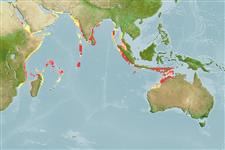>
Ovalentaria/misc (Various families in series Ovalentaria) >
Pomacentridae (Damselfishes) > Chrominae
Etymology: Chromis: Greek, chromis = a fish, perhaps a perch (Ref. 45335); xouthos: Name from Greek 'xouthos' meaning yellowish-brown; refers to the overall coloration..
Environment: milieu / climate zone / depth range / distribution range
Ecologia
marinhas associadas(os) a recifes; intervalo de profundidade 12 - 50 m (Ref. 90102). Tropical
Indian Ocean: Maldive Islands and Chagos Archipelago to off the Andaman Sea coast of Thailand; and Indonesia; probably Andaman and Nicobar Islands, and Mergui Archipelago, off Myanmar.
Tamanho / Peso / Idade
Maturity: Lm ? range ? - ? cm
Max length : 9.2 cm SL macho/indeterminado; (Ref. 75747)
Descrição breve
Morfologia | Morfometria
Espinhos dorsais (total): 13; Raios dorsais moles (total): 12; Espinhos anais 2; Raios anais moles: 11 - 12; Vértebras: 26. This species is distinguished by the following characters: DXIII,12; A II,11 (rarely 12); pectoral rays 19 (rarely 18); spiniform caudal rays 3; tubed lateral line scales 16-17; gill rakers 6-7 + 19-21 (total, 26-28); body depth 1.9-2.0 in SL; colour when alive is mainly golden brown with yellowish caudal fin and pale bluish-grey pelvic fins (Ref. 75747).
This species is usually encountered in clear water over coral reefs at depths between about 12 and at least 45 m. Habitats include both gradually sloping bottoms and steeper drop-offs, but in the former case it was restricted to depths greater than 20 m in the vicinity of isolated, small patch reefs. Generally, this species forms aggregations ranging from just a few fish to at least 20-30 individuals, feeding on plankton up to several meters above the bottom. The fish retreat to caves, crevices, and ledges when approached closely by divers (Ref. 75747). Life history characteristics for the family specify that this species is oviparous, with distinct pairing during breeding (Ref. 205). Eggs are demersal and adhere to the substrate (Ref. 205). Males guard and aerate the eggs (Ref. 205).
Life cycle and mating behavior
Maturidade | Reprodução | Desova | Ovos | Fecundidade | Larvas
Life history characteristics for the family specify that this group is oviparous, with distinct pairing during breeding (Ref. 205). Eggs are demersal and adhere to the substrate (Ref. 205). Males guard and aerate the eggs (Ref. 205).
Allen, G.R. and M.V. Erdmann, 2005. Chromis xouthos, a new species of damselfish (Pomacentridae) from the East Andaman Sea and Central Indian Ocean. aqua, J. Ichthyol. Aquat. Biol. 10(3):89-94. (Ref. 75747)
Categoria na Lista Vermelha da IUCN (Ref. 130435)
Ameaça para o homem
Harmless
Utilização humana
Mais informação
Idade/TamanhoCrescimentoComprimento-pesoComprimento-comprimentoFrequência de comprimentoMorfometriaMorfologiaLarvasDinâmica larvarRecrutamentoAbundânciaBRUVS
ReferênciasAquaculturaPerfil para aquaculturaEstirpesGenéticaElectrophoresesHereditariedadeDoençasProcessamentoNutrientsMass conversion
ColaboradoresFotografiasStamps, Coins Misc.SonsCiguateraVelocidadeTipo de nataçãoÁrea branquialOutras referênciasCérebrosVisão
Ferramentas
Relatórios especiais
Descarregue XML
Fontes da internet
Estimates based on models
Preferred temperature (Ref.
123201): 27.8 - 29, mean 28.4 °C (based on 30 cells).
Phylogenetic diversity index (Ref.
82804): PD
50 = 0.5000 [Uniqueness, from 0.5 = low to 2.0 = high].
Bayesian length-weight: a=0.01778 (0.00796 - 0.03971), b=2.99 (2.81 - 3.17), in cm total length, based on LWR estimates for this Genus-body shape (Ref.
93245).
Nível Trófico (Ref.
69278): 3.0 ±0.1 se; based on size and trophs of closest relatives
Resiliência (Ref.
120179): Elevada, tempo mínimo de duplicação da população menor que 15 meses (Preliminary K or Fecundity.).
Fishing Vulnerability (Ref.
59153): Low vulnerability (10 of 100).
